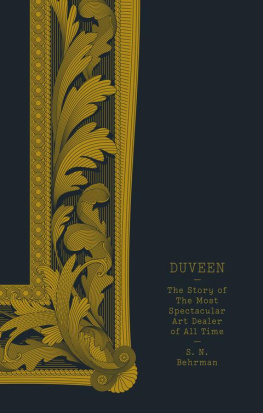BERNARD BERENSON

Bernard Berenson
A Life in the Picture Trade
RACHEL COHEN

New Haven and London
Copyright 2013 by Rachel Cohen.
All rights reserved.
This book may not be reproduced, in whole or in part, including illustrations, in any form (beyond that copying permitted by Sections 107 and 108 of the U.S. Copyright Law and except by reviewers for the public press), without written permission from the publishers.
Yale University Press books may be purchased in quantity for educational, business, or promotional use. For information, please e-mail sales.press@yale.edu (U.S. office) or sales@yaleup.co.uk (U.K. office).
Set in Janson type by Tseng Information Systems, Inc.
Printed in the United States of America.
Library of Congress Cataloging-in-Publication Data
Cohen, Rachel, 1973
Bernard Berenson : a life in the picture trade / Rachel Cohen.
pages cm. (Jewish lives)
Includes bibliographical references and index.
ISBN 978-0-300-14942-5 (hardback)
1. Berenson, Bernard, 18651959. 2. Art historians
United StatesBiography. I. Title.
N7483.B47C64 2013
709.2dc23
[B]
2013022541
A catalogue record for this book is available from the British Library.
Frontispiece: Bernard and Mary Berenson, Fridays Hill, 1901. Biblioteca Berenson, Villa I TattiThe Harvard University Center for Italian Renaissance Studies, courtesy of the President and Fellows of Harvard College.
This paper meets the requirements of ANSI / NISO Z39.481992
(Permanence of Paper).
10 9 8 7 6 5 4 3 2 1
For Matthew Boyle
In the eye would lie for him the determining influence of life: he was of the number of those who, in the words of a poet who came long after, must be made perfect by the love of visible beauty.
Walter Pater, Marius the Epicurean
CONTENTS
BERNARD BERENSON
Introduction
I N THE SUMMER OF 1895, Bernard Berenson, who turned thirty that June, was laboring over a follow-up volume to his successful first book, The Venetian Painters of the Renaissance. He wanted the projected book on the Florentine painters to convey to his readers not dry details of biography or composition but what he thought of as the artistic personalities of the painters. He disdained experts who simply pronounced paintings genuine or not; he wanted to formulate an aesthetic philosophy that would give his readers an understanding of a deep personal experience of art. That summer, he and his companion, Mary Costelloe, who would later become his wife, were living in separate apartments close together in Florence. After years of relative poverty, he was beginning to make a little money on commissions for paintings he helped collectors to find. Within a few years, he would be one of the most celebrated connoisseurs of Italian Renaissance art and would find that much of his time was given to authenticating pictures for dealers and entertaining wealthy guests, but that summer his time was still his own, and he and Costelloe spent long afternoons arguing about what a person really felt standing in front of a Botticelli.
If you look closely at the lines of a Botticelli, Berenson wrote in the Florentine Painters, if you really give yourself over to the lines that render the movements of the tossing hair, the fluttering draperies, and the dancing waves in the Birth of Venus, you will see how the lines alone have the power of stimulating our imagination of movement. Anticipating the coming century of abstract work, Berenson noted that here we are seeing the pure values of movement abstracted, and the effect of this on us is that the painting seems to be directly communicating life. A Botticelli painting is not merely telling a story, it holds the same relation to representation that music holds to speech. This, Berenson said, was the art of arts. Berenson worked with an unusual breadth of reference for his day: Sandro Botticelli may have had rivals in Japan and elsewhere in the East, but in Europe never. He was, Berenson concluded, the greatest artist of linear design that Europe has ever had.
Berensons approach to art galvanized American readers, who, when they came across this passage, had generally never seen a Botticelli. The phrases are still surprisingly evocative of what we feel faced with a Botticellithe sense of rippling movement, the exhilaration of the wind. The Birth of Venus has become a pervasive painting, the object of pilgrimages and constantly present in reproductions, but when Berenson wrote his consideration in 1895, Botticelli was not much studied and was widely considered a minor painter. Just the year before, Berenson had helped Isabella Stewart Gardner to acquire a Botticelli, of Lucretia. She had paid for it the equivalent of about $16,000. It was the first Botticelli in America. A few years later, in 1898, when an important Botticelli of Saint Jerome was offered to the British National Gallery for 500, or about $2,500, the museum declined. As the century turned, though, tastes changed. More and more American viewers and collectors came into contact with the paintings of medieval and Renaissance Italy, and Berensons works were an important guide to their appreciation.
Bernard Berenson was one of the leading figures in a new generation of seeingone that grew up on the works of Walter Pater and John Ruskin, was newly open to the intellectual and sensual excitement of the paintings of the Italian Renaissance, and had new access to these pictures because travel had been made easier and photographic reproductions had become common. What Berenson made of these influences and opportunities was remarkable. He had an encyclopedic visual memory, and he mastered the careers and paintings of hundreds upon hundreds of Italian painters. His gift for discerning the artistic personalities of different painters and for naming their qualities with a few choice phrases meant that, when his readers encountered the works of these artists, the pictures seemed to come forward, ready to be seenCosimo Tura: His world is an anvil, his perception is a hammer, and nothing must muffle the sound of the stroke; or Fra Angelico: The sources of his feelings are in the Middle Ages, but he enjoys his feelings in a way which is almost modern.
In the Gilded Age, a generation of American collectors and art historians and museum professionals came to their understanding of what interested them in Italian Renaissance art in significant part by reading Berensons work and by listening to him talk. In Berensons descriptions, they heard echoes of their own interestsin scientific experiment and in the progress of humanismand of their own deep involvement in commerce. The cohort of Berensons listeners and readers built most of the major American collections and museums, and the effect of Berensons way of seeing goes on being felt to this day.
But Berenson himself is an odd figurehe was dignified and erudite but also capricious and heedlessly romantic; his arrogance was matched by his self-contempt. His contemporaries thought of him as one of the greatest perceivers of paintings, a man whose sensitivity to art had seldom been surpassed. Now he isnt especially well known outside of art historical circles, and when his name appears, it seems smudged around the edges by questions about his reputation and by patches of secrecy that obscure aspects of both his private and public lives. For, along with being a connoisseur of paintings, he, too, was deeply involved with business. His fine eye made him a great authenticator of the notoriously difficult-to-attribute Italian old masters, and this led him to have, for twenty-five years, a profitable, and secret, partnership with the famous dealer Joseph Duveen. The obscurity with which Berenson shrouded this relationship followed in part from a lifelong practice of keeping his origins, and methods of survival, to himself.
Next page












